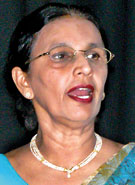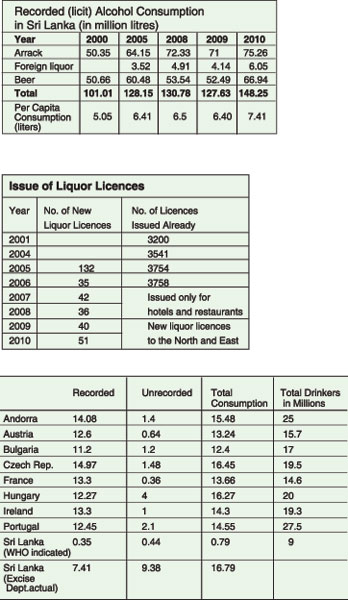I became interested in the problem of alcoholism when I assumed duties as consultant physician, Teaching Hospital Colombo North – Ragama. The majority of patients were admitted with diseases directly due to the toxic effect of alcohol, in others the consumption of alcohol complicated other co-existing diseases they had such as – pneumonia, hypertension, and rat fever or leptospirosis. Very soon I was convinced that the residents of Ragama were indeed very true to form and fully convinced me of the suitability of the name for their home town “Raa-gama”.
 |
| Dr. Wijesundere delivering the
lecture |
Ragama, was indeed a far cry from my former place of work. Base Hospital Polonnaruwa where the major problems in 1986 -1988 were malaria, snake bites, encephalitis, and poisoning. I rarely encountered a patient with alcohol.
However the situation has now changed – malaria has disappeared but alcohol related diseases are widely prevalent in Polonnaruwa today. At the Sri Jayewardenepura General Hospital where I now work, alcoholism was the leading cause of deaths among males admitted to our unit annually for many years.
History of alcohol consumption
The history of alcohol consumption is as long as the history of civilization and dates back over 10, 000 years. Initially, man fermented barley and brewed beer. 5000 years later fruits were fermented and wine was made. 2600 years ago, Lord Buddha realized the evil of alcohol and advised all His disciples to refrain from drinking alcohol.
Abstinence from alcohol is in fact the fifth basic precept of Buddhism. Lord Buddha mentioned 48 evils of alcohol dependence in the Kumbha Jataka which He preached to King Sarvamithra and King Kosala who were addicted to alcohol.
History of alcohol consumption
in Sri Lanka
Historic and cultural evidence indicate that Sri Lankans did not consume alcohol significantly for several centuries and lived by Buddhist principles, observing the five precepts. However in 1505, with the Portuguese invasion of Sri Lanka, the situation changed. They destroyed our civilization and influenced the drinking habit amongst the Sri Lankans. The Dutch continued the propagation of alcohol, while the British liberally introduced licences to open up taverns in every nook and corner of the country, increased state coffers and promoted the drinking habit widely via the “Toddy Act of 1912”
Alcohol –Consumption In Sri Lanka – magnitude of the problem
Sri Lanka has an extremely high per-capita consumption for alcohol – 7.4 litres for recorded or licit alcohol (Excise Department - 2010.)
For males only above 15 years the consumption rate is 15.2 litres (Sober Sri Lanka -1997)
Community service done by the Alcohol and Drug Information Centre (ADIC) shows that 43% urban dwellers, 65% of male estate workers, 25% of female estate workers and 50% of fathers of school children consume alcohol in Sri Lanka.
Among new entrants to the universities in Sri Lanka 18% consume alcohol. (Drinking Culture in Colombo – Dr. D. R. Abeysinghe, 2008)
This clearly indicates that “alcohol culture” has clearly penetrated every strata of our society and infiltrated intricately into the social framework of our country.
Alcohol Consumption in Sri Lanka 2000 -2010 – Excise Dept.
The statistics indicate that alcohol consumption has soared with Lankans guzzling 75.2 million litres of arrack and 67 million litres of beer and 6 million litres of foreign liquor for 2010. Apart from the transient reduction in consumption of beer in 2010, probably under the temporary influence of National Authority on Tobacco & Alcohol; the consumption of arrack, beer and foreign liquor has steadily increased in the decade under review.
These statistics confirm beyond doubt that alcohol consumption has increased considerably and proved that the ‘National Authority on Tobacco & Alcohol’ of 1996 has been a complete failure.
Let us compare our alcohol consumption per capita with the global alcohol consumption data per capita from the Global Status Report on Alcohol and Health, WHO – 2010.
The figures for Sri Lankan alcohol consumption, as recorded by the WHO, are woefully inaccurate. Considering the information given by the Excise Department, Sri Lanka has the world’s highest consumption rate at 16.79 litres per capita. We have reached the gold medal for alcohol consumption!
Causes of alcohol consumption
Why do Sri Lankans drink?
To many Sri Lankans, alcohol appears to be a panacea for everything.
In a survey done at SJGH, on “Drinking Trends – Quantity - Causes, and Consequences” among 50 patients (50 males, 1 female) – arrack was the major beverage (86%) followed by beer (50%), illicit brew (46%). The majority (76%) had high consumption rates of more than 250 ml per day. The major causes were: drinking alcohol with friends, drinking for recreation, for insomnia, for tiredness, for joy and sorrow, for laziness or courage, for heat or cold and sometimes no reason at all!
Consequence of Alcohol|
Consumption in Sri Lanka
Alcohol consumption is a major health and social problem in Sri Lanka. The magnitude of the problem is reflected in the rising incidence of,
- Hospital admissions due to alcohol related diseases such as cirrhosis, non-communicable diseases, depression and suicide.
- Road traffic accidents, crime, violence and homicide.
- Violence and sexual abuse of women and children, especially in rural areas.
The consumption of alcohol over a period of time leads to deterioration of both physical and mental health, interpersonal relationships and smooth economic and social functions. Alcoholism also leads to deterioration of moral and spiritual standards and often destroys family life on a drastic scale.
The psychological aspects of alcoholism: Alcohol consumption leads to physical and psychic dependence and development of tolerance. Alcohol is also addictive and psychoactive like heroin and tobacco. But unlike these which are taboo in society alcohol is widely accepted - how come? A Chinese proverb sums it all:
A man takes a drink,
The drink takes a drink,
And the drink takes the man!
Alcohol and Cirrhosis
Sri Lanka has the second highest rate of Cirrhosis in the world - 55/10,000 population. We are second only to Moldova, a nation of Vodka drinkers.
Consumption of more than 230 ml (1/4 bottle of arrack) for a period of time, undoubtedly leads to cirrhosis. Cirrhosis is the 6th leading cause of death in Sri Lanka and the fourth cause of admissions to government hospitals.
Alcohol consumption over a period of time leads to fat deposition it the liver followed by degeneration of the liver leading to cirrhosis. Fluid accumulates rapidly in the abdomen and death results from liver coma and hemorrhage from stomach.
Alcoholism is also associated with cancer of the liver, stomach ulcers and pancreatitis.
Alcohol is a definite carcinogen and is associated with cancer of the esophagus, stomach, oral cavity, pharynx, large bowel and the urinary bladder.
It is also associated with degeneration of the brain and memory loss (dementia), difficulty in walking due degeneration of peripheral nerves and muscles. It also leads to impotence and infertility in the male.
In the heart, alcohol causes degeneration of the heart muscle, high blood pressure, high cholesterol, heart attacks and death.
Alcohol abuse causes many psychiatric problems such as jealousy, depression, induces epilepsy and increases the tendency to commit suicide.
The main reason for the increase in alcohol consumption nationwide is the ready and easy availability and accessibility of alcohol even in the remotest parts of the country via wine stores, restaurants, toddy taverns, hotels and even supermarkets. There are an un-estimated number over 200,000 sites producing and distributing illicit (unrecorded) alcohol.
The National Authority on Tobacco and Alcohol (NATA) bill was initially introduced to parliament by Ven. Omalpe Sobitha M.P. as a private member’s motion and subsequently following amendments by the Supreme Court, was unanimously passed by the House in September 2006. The purpose of the bill was to reduce and control production and reduce consumption of alcohol and tobacco and to punish offenders disobeying the act.
It is apparent that following the introduction of the NATA, initially significant number of detections were made and considerable revenue was collected by the courts through fines collected. However, with time NATA detections have reduced but production and consumption of alcohol has skyrocketed.
The outstanding profits of the Distilleries Company (DCSL) of Sri Lanka clearly indicate that we have become nation of boozers.
The alcohol industry focuses solely on profits gained from alcohol sales with total lack of consideration for moral and ethical issues. The industry actively works to increase its market share and never seems to be content with profits obtained despite being a blue-chip company in Sri Lanka.
Having identified that the smell of arrack is most repulsive to non-drinkers, the DCSL has now introduced fresh fruity flavours to entice the young with mango, lemon and pineapple flavours.
I am sure you are now convinced that Sri Lanka has sadly transformed from “The Granary of the East” during the time of King Parakramabahu, to the “The Brewery of the World” despite the NATA and the “Mathata-thitha policy” of the government of
Sri Lanka.
Thus it is imperative that the government and responsible religious and social bodies should work together and recommend meaningful guidelines and implement fully the NATA and the Mathata thitha policies of the government to overcome the terrible scourge of alcoholism in Sri Lanka, if we are to save our countrymen from the evil of alcohol dependence and self-destruction. |



